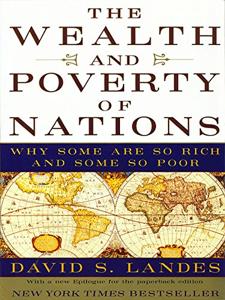
Want to learn the ideas in The Wealth And Poverty Of Nations better than ever? Read the world’s #1 book summary of The Wealth And Poverty Of Nations by David S. Landes here.
Read a brief 1-Page Summary or watch video summaries curated by our expert team. Note: this book guide is not affiliated with or endorsed by the publisher or author, and we always encourage you to purchase and read the full book.
Video Summaries of The Wealth And Poverty Of Nations
We’ve scoured the Internet for the very best videos on The Wealth And Poverty Of Nations, from high-quality videos summaries to interviews or commentary by David S. Landes.
1-Page Summary of The Wealth And Poverty Of Nations
A Whistle Stop Tour of World History
History has shown us that societies that are the most successful at building businesses and economies have been those who were able to follow technological advances. Those societies became more modern, as seen in these pivotal historic events.
A Case in Point
In 1836, Nathan Rothschild, a wealthy businessman who lived in Europe during the Industrial Revolution, died of an infection that was not curable by his era’s best doctors. Medicine has advanced greatly since then. In general, people live longer due to better sanitation and medicine. Back in the mid-1800s when Rothschild died, it was easy for anyone to get sick from gastrointestinal infections because toilets were unsanitary and underwear wasn’t washable or changeable; hand-washing wasn’t common practice either. Jews and Muslims had healthier lives because their religious beliefs required them to wash frequently. The Industrial Revolution changed all this with its technological advances such as cheap cotton clothing and mass-produced soap which made hygiene easier for everyone.
Better Nutrition, Healthier People
As food production improved, people were able to get more and better nutrition. This led to fewer deaths from disease, which is caused by poor nutrition. It also helped reduce famines because it allowed for more reliable and quicker transport of food supplies. In addition, better supply meant a greater variety of foods could be eaten, even during wartime when certain countries are unable to grow enough crops to feed their populations. These improvements can be seen in the height and weight gains among immigrants who move from poorer countries where they have less access to good food sources into richer ones with universal healthcare systems that allow them better access to nutritious foods.
The distribution of medical and scientific knowledge is not even. There are many poor countries that have less access to this information, but the gap between them and rich countries is closing. The East-West division isn’t as relevant anymore because now it’s more about North-South or West vs Rest. Wealth gaps are growing in some places with Switzerland having a ratio of 400:1 compared to Mozambique which has a much smaller income per person. Rich countries should help poorer ones without being accused of Eurocentrism (being biased towards Europe).
Climate Extremes
Science has allowed us to live in places that are warmer and colder than where we would naturally be. Scientists must endure extreme conditions when they work, while the rest of us avoid them as much as possible. Extreme heat is more uncomfortable than cold weather. We have developed coping mechanisms for hot weather such as siestas, but air conditioning was only invented after World War II. Weather can create illnesses, so it’s important to prevent illness instead of curing it if you want to save money or time on medicine. The germ theory was an advancement in disease prevention because governments could now focus on preventing people from getting sick instead of focusing on curing them once they were ill.
Water resources can help draw people to a region or keep them there. The great rivers, such as the Nile and Indus, drew settlement because they deposited fertile soil in their deltas, which encouraged agriculture and nearby communities. Moderate climates give people more energy than extreme ones do. Western Europe has moderate winters and year-round rainfall, an unusual combination that provides reliable water for farming and living comfort.
Because of the thick forests in Europe, horses had to be bred to forage for food, which resulted in larger horses. However, smaller Mongolian and Arabian horses that were able to withstand harsh climates gave the East Asian people an advantage over Europeans. European waste was used as fertilizer while Chinese human waste spread parasites and worms. Even so, rich soil from the Nile River Delta area could not compete with China’s fertile land. European agricultural techniques couldn’t beat China’s natural advantages either because it relied on its population rather than slavery and grew by dint of its booming population growth due to early marriage without financial limitations.





